Justin Quill: how I conquered an Antarctic marathon with ten weeks' training
A lawyer, a comedian, an ex-footballer and a filmmaker decide to run a marathon in Antarctica. Now, what could possibly go wrong? Find out how they braved injuries, storms and went without mobile reception in the name of charity.
VIC News
Don't miss out on the headlines from VIC News. Followed categories will be added to My News.
I’ve always enjoyed exercise and I’ve always enjoyed a challenge. And there are some challenges that just need to be checked off the bucket list. Running a marathon is one of them — even if you’re not a “runner”; and I’m no runner.
The longest run I’d done before this race was a half marathon when I was 19. But this is why, why, when and with whom I ticked a box and ran a marathon this month … in Antarctica!
MORE JUSTIN QUILL:
‘TROLLEY MAN’ HAS TAUGHT US A LESSON IN CARING
BUCKS AND THE MAGPIES: IT’S A LOVE THING
IT’S TIME TO IDENTIFY YOUNG THUGS
WHY THE CHALLENGE?
It wasn’t my idea to run a marathon in Antarctica. Somewhere between my racing buddies — former AFL premiership footballer Campbell Brown, comedian Tommy Little and film maker Lachlan Spark — the idea came up.
I was late to the party. Literally. It was an after-party at the Polo in Portsea. And somewhere post-midnight I ran into Tommy. The conversation is hazy but I remember I woke up the next day knowing I was going to be running a marathon in Antarctica.
Tommy decided we should make some good from this stupidity and we all got on board to raise money for Spinal Injury Australia. A great cause — especially given it appears researchers are close to some major breakthroughs.
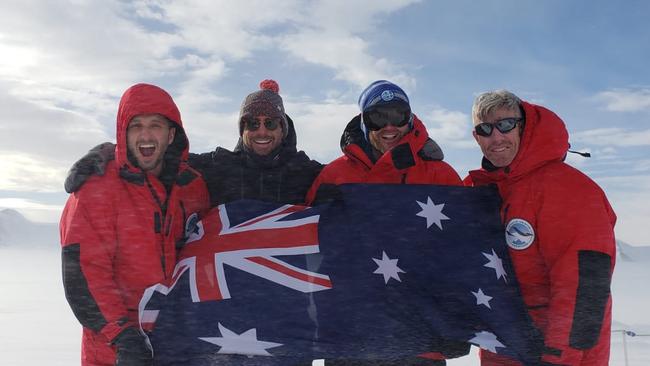
THE TRAINING
After that night at the polo, I took a couple of weeks getting around to entering the event. In that two weeks, all the 53 spots available to do the race had been taken out.
Saved, I thought.
I asked to be put on the waiting list but thought that would be the end of it. But I forgot that Campbell Brown was doing the run. Browny pestered both me and the organiser of the event persistently for months with constant emails and phone calls.
By the time September rolled around, Browny, Tommy and Sparky had been training hard and doing some serious kilometres (actually, Tommy had mainly been doing his kilometres in a car). I had done none, assuming that I wasn’t going to get to start the race.
Another box left unticked, it seemed.
But in late September, I got the call up. That meant I had about 10 weeks to prepare.
I had 5 weeks of really hard work building up to do a couple of runs over 30 kilometres. Normally you’d want to spend more time getting from 5km runs to 30km runs, but I didn’t have the luxury of time.
The short length of time getting from my regular run distance of 5km to 30km had taken its toll and injuries started to set in.
The worst injury was a persistent foot injury at the base of my foot causing constant pain.
I went over on my ankle a couple of times in runs. Nothing a good bit of icing wouldn’t fix.
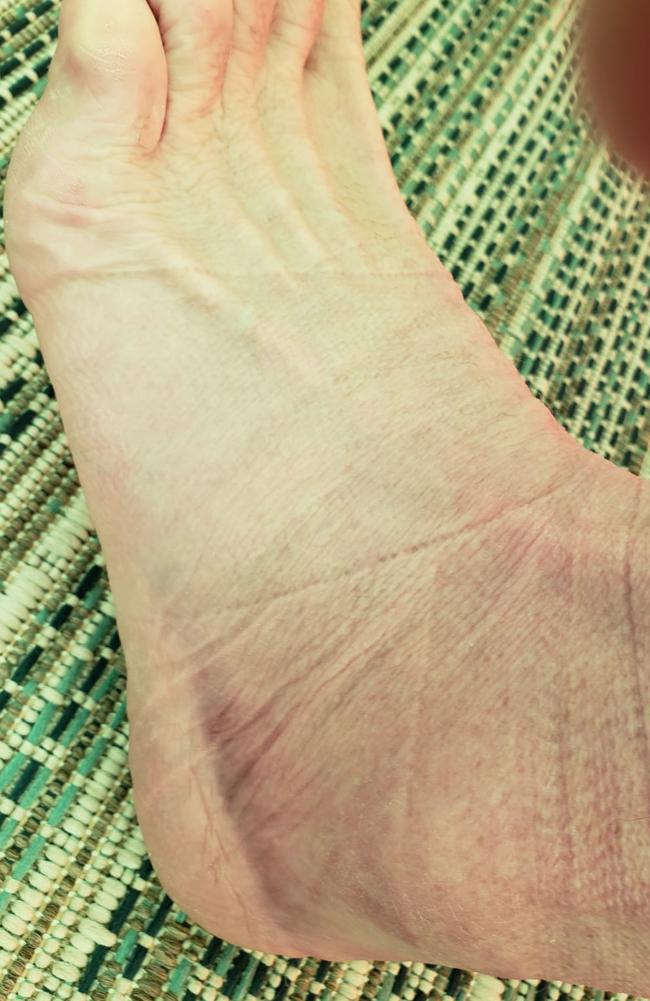
In fact, after every run I would have either an ice bath or, at the very least, have my foot in a bucket of ice and water.
I had cortisone injections into my foot to reduce the swelling and with three weeks to go, I was set to do my 35km run. This would set me up for my taper and give me confidence that I could do the 42.1km on race day.
At the 19km mark I pulled my calf — obviously, a result of the problems I’d been having with my foot. I had to Uber it home that day. That’s pretty embarrassing.
About a week later, I organised for the four of us to run at the Coles frozen warehouse in Laverton. This is a massive warehouse where the temperature is minus 21. That was perfect for us.
It was exactly the temperature we were expecting in Antarctica — just without the wind chill factor. We did the run — with the Coles workers watching on in amusement — but I had to stop early because of my calf.
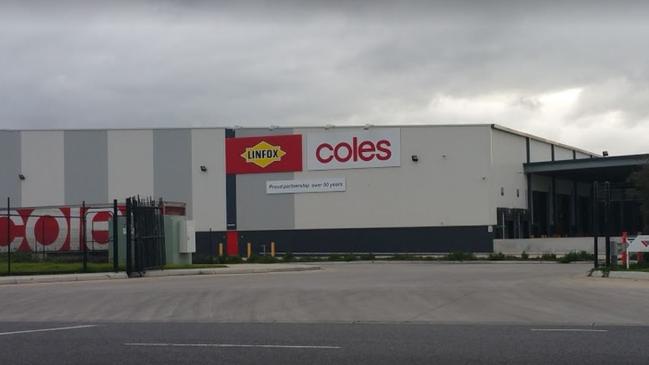
After nine days of no running — other than 3kms in a frozen warehouse — and with less than two weeks to go, I was on a run on a Monday morning when I came around a corner head first into a bike at full speed. I hit the deck, but so did he.
As I limped home — and missed most of my morning appointments — I was fearing the run was over for me. My foot was killing me and I assumed a break.
As it turned out there was no fracture. Thankfully. But I would hardly run in the last couple of weeks. This was going to be the ultimate taper!
So after several injuries, an MRI, plenty of cortisone injections and not enough kilometres in my legs, I knew I wasn’t properly prepared. I was going to have to pump in the painkillers and then just tough it out.
This box was going to get ticked!
THE EQUIPMENT
We were expecting a temperature of minus 20. No major dramas — although I’ve only been to the snow a few times and really don’t like the cold or handle it well. But that doesn’t take account of the wind chill factor. That would be the problem.
So to guard against that, I bought a heap of equipment I’m unlikely to ever use again.
If anyone is thinking of running in Antarctica and you’re about 6 foot tall — give me a call, I have the gear for you.
The head and hands are always the problem. I had three layers on each.
I ran in running tights, with a thermal over the top of that and then a thin Gortex-type layer above that.
THE TRIP
Sunday, 9 December 2018
We fly out for Punta Arenas in Chile. “Puntas” — as we affectionately come to know it — is the southernmost city in Chile. There’s nothing there to do other than wait for your expedition to Antarctica to leave. So we wait.
Monday, 10 December 2018
We have a briefing with the other competitors.
This is a strange experience. This is where we meet the other three Australians doing the run, including a surgeon who would go on to place second in the race.
It’s also where we were introduced to the problem the weather could cause us getting into and out of Antarctica. At the briefing we are told we would be leaving for Antarctica a day early to ensure we would be able to get into Antarctica.
But later that day, I have an issue. I fall on a gutter outside my hotel in Puntas. My travel buddies don’t show a great deal of concern. Later, my ankle blows up like a balloon and is black and blue with bruising. It’s going to make the run very hard.
Tuesday, 11 December 2018
We get up early. I’m nervous. I pack the things I need for my three day trip to Antarctica and leave the rest in the hotel. We board buses for the airport. It feels like no other airport transfer with everyone still trying to get to know each other amid an air of nervousness and tiredness on the bus. But then we hit airport security and you realise nothing has changed. Yet.
After security we go to our gate and from here, everything becomes different. Looking out the window you could see all the other typical airliners with their typical airline markings on the tail.
You could also see our plane: a Russian cargo plane built in the early 1970s called an Ilyushin. No windows. No nice airline tail insignia but with some Russian military ground crew working on it.
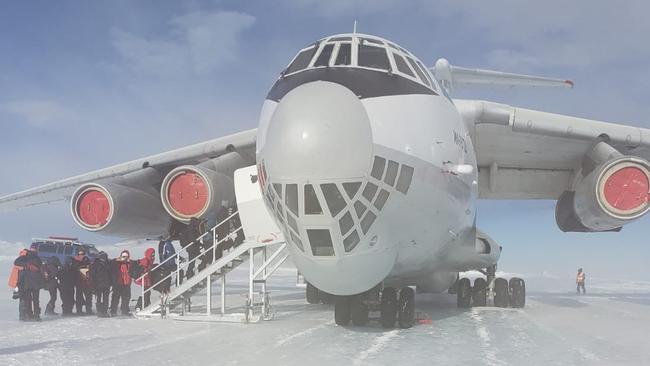
I’ve never been on board a cargo plane but the first thing that strikes you is that it has no ceiling. Just the plane’s shell, making it much higher inside than you’re used to. The second thing is that there are basically no windows — just one on either side of the plane. And the toilet is, well, the toilet is small.
Forget about your usual safety briefings or in-flight attendant call buttons, there’s none of that.
Before we know it, we’re off.
The 4.5 hour flight goes quickly. There’s not much talk on the flight. That’s probably partly the nerves — but mainly the noise from the Ilyushin’s engines.
Arriving in Antarctica was a shock to the senses. I felt like I’d landed on the moon. Aside from the strange sight of seeing the enormous Ilyushin parked on the ice — it was the absolute cold and the sight of just white for as far as you could see. Everyone seemed to be in a bit of shock and making up for it by taking photos.
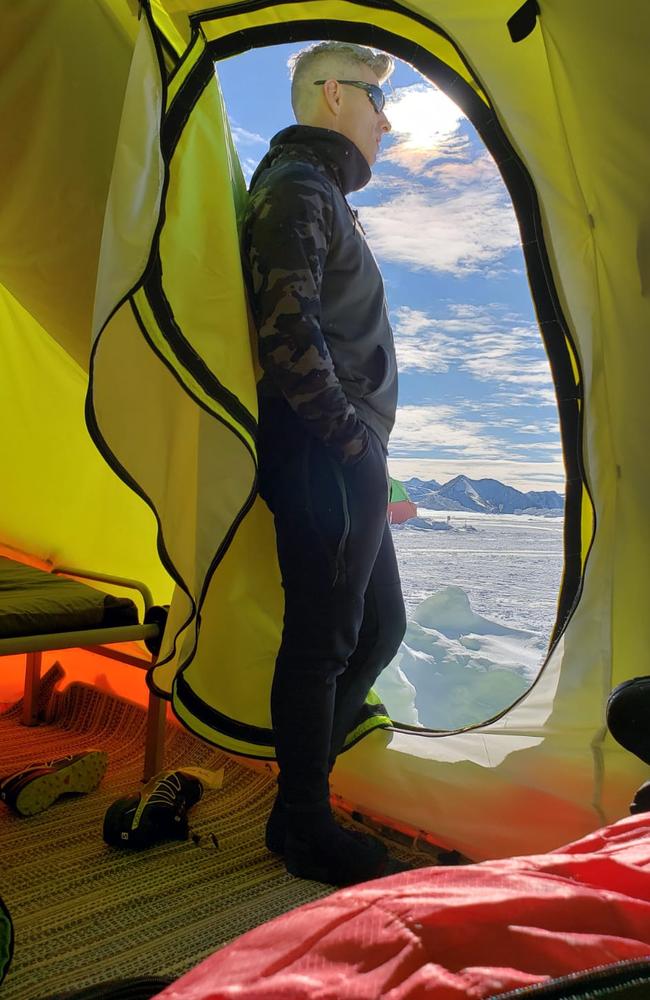
We board snow mobiles and head to the Union Glacier Camp where we’re shown to our accommodation — two person clam tents.
There would be no complaints about the accommodation or the camp set up. The ‘mess tent’ was warm and the food hot. And after the run they would have plenty of beer — so all the Australians were happy.
Arriving at camp, we were struck by how different the temperature and weather conditions were to the runway only a few kilometres away. Here, we could walk around and talk without feeling like we were going to get frostbite.
The sun was out and the visibility was amazing — allowing us to see the mountains all around us. And take photos of every single thing we could think of. But that could change from day to day — or even hour to hour.
There was also talk that we should run the race straight away. The conditions were perfect. Some suggested taking a vote. I was hardly able to walk and my ankle had blown up the size of, well, the size of an ankle that might have a fracture or torn ligaments.

Although everyone else was nervous, I was freaking out because I feared I wouldn’t make it — or even if I did, it would be just such a painful experience. The second option would be the correct one.
After realising the sun doesn’t go down — at all — at Union Glacier we finally go to bed. Getting up to the toilet in the night was strange as it was like getting up in the middle of the day with bright sunshine — yet the camp felt ‘asleep’.
Wednesday, 12 December 2018
There’s no internet at the Union Glacier camp and certainly no mobile phone connection. Instead, you start to develop a different type of connection with others. You connect by talking and playing cards. A lot of cards! You also can’t stop looking at the views.
Everyone on the trip went for a run that night to allow the organisers to get some footage of us running. That made everyone nervous because, even though the weather was exceptional, we realised the terrain underfoot was going to make running incredibly difficult.
For me, I realised that there could not have been a worse injury than a bad ankle for the uneven ice we would be running on. I simply couldn’t complete that training run. I try to put the run and my ankle out of my mind as I hobble and limp around the camp.
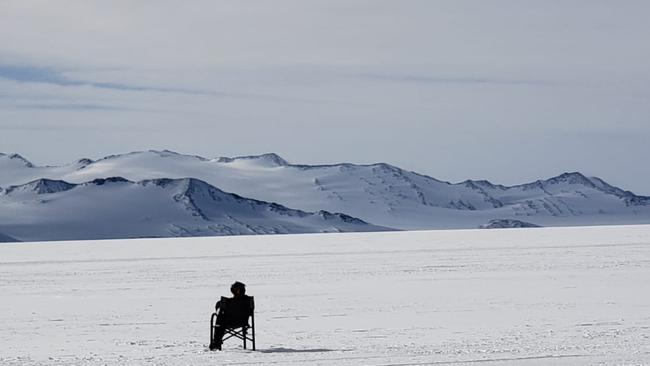
One of my travel buddies, comedian Tommy Little, agrees to do a stand-up comedy set after dinner. I’m nervous for him because of all the different nationalities. I shouldn’t have been. He was brilliant. And from Tommy’s set, I felt like all the different individuals or groups on the trip — together with the staff at the camp — all started to really bond.
We went to bed that night pretty happy. But very nervous, because we’d been told the race would be the next day.
Thursday, 13 December 2018
Race day. I eat — but not much. I’m too nervous. My ankle is still very sore. I strap it — although I’m not sure that will do much.
Before I know it, we’re off and running. The conditions are the worst they’d been on the trip. There was almost no visibility and the beautiful scenery and mountains around the camp had disappeared. It wasn’t as cold as I expected — probably just under minus 10 degrees — but when you felt the wind, you had to have your balaclava up to shield your face from frostbite. Everything else was, of course, well covered.
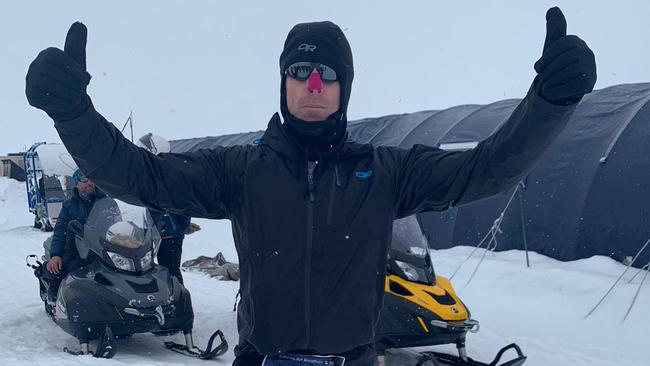
We had to complete four laps of just over 10.5km per lap. My painkillers seemed to be working, although the uneven ground was certainly causing me problems. My first two laps felt good. I was holding back and feeling like I’d easily make it.
The run was a little lonely because there were no spectators — only the camp staff manning the drinks station — and it was difficult to speak with the other competitors given the conditions and our clothing.
At the halfway point, I stopped to change my thermal top as it was drenched in sweat — not ideal when you turned into the wind around “poo corner” — so named because someone in a previous year had stopped and made a deposit on the corner which stayed there for the rest of the race.
After my quick change I took off running again and felt good. Terrain and freezing cold wind around poo corner aside, I wasn’t finding the run too. Then I pulled my calf. No doubt my ankle injury had taken its toll by putting pressure on my calf. Once it blew out, the rest of my leg started to seize up. I was in a world of trouble and still with 15km to go. People started passing me and while I tried to stay with them, I just couldn’t. My “run” was more like a hobble.
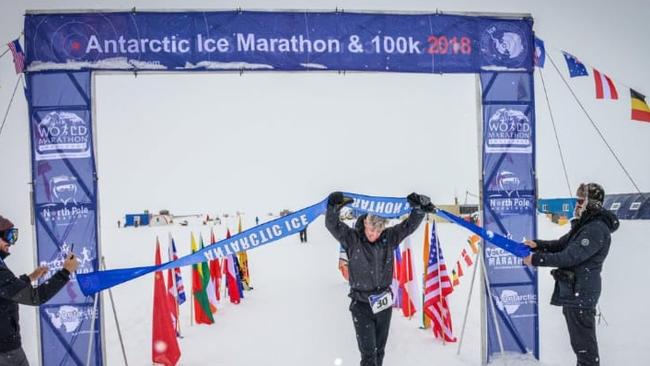
When I passed the start/finish point just over 31kms into the race it seemed the obvious thing to just retire injured. Frankly, if it had been a marathon in Australia I’ve no doubt I would have. I had slowed to a pace not much faster than a walk and the final lonely lap seemed like a bad idea.
But there were still plenty of people behind me. And knowing my three travel partners were in front and travelling well, I didn’t want to be the only one not to make it. So I kept going.
That last lap went forever. Long. Boring. And painful.
As I finally ran across the finish line there was no big celebration from me. I later saw people crossing the line and posing for photos and really enjoying the experience. I didn’t. I was just in a world of cold hurt.
Despite my exhaustion and the pain from my leg (it was now not just an ankle injury!), I joined the rest of the competitors that night in the mess tent where we had plenty to drink and congratulated each other on the race. My travel buddies had ran particularly well. Lachlan finished 9th, Tommy surprised everyone finishing 12th while Campbell finished a very respectable 23rd.
Although it was a great experience, I sensed that everyone had done what they had come there to do and were looking forward to getting out of Antarctica the following day.
Friday, 14 December 2018
There would be no flights out today. That message was a lot clearer than the skies and visibility at the camp.
So to cards and talking it was.
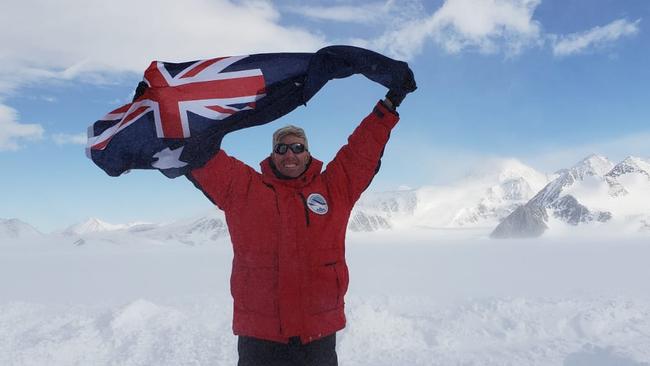
Saturday, 15 December 2018
We are told to pack our backs and “check in”. Just after check in, and with the mood of the camp at a high — because we were getting out — we are told we can’t fly out. The weather was about to turn and it was just too dangerous. And turn it did. A storm hit the camp that was said by key staff to be the worst in more than a decade.
Sunday, 16 December 2018
No flights today. So far everyone on the trip had been calm and relaxed about the extra day or two in Antarctica. But by now, the mood in the camp was starting to waver. Especially given we weren’t able to tell when we would be flying out.
We were told there was a small window where the weather might improve on Monday night and if we didn’t get out in that window, we would probably be staying until at least Christmas.
Everyone was nervous.
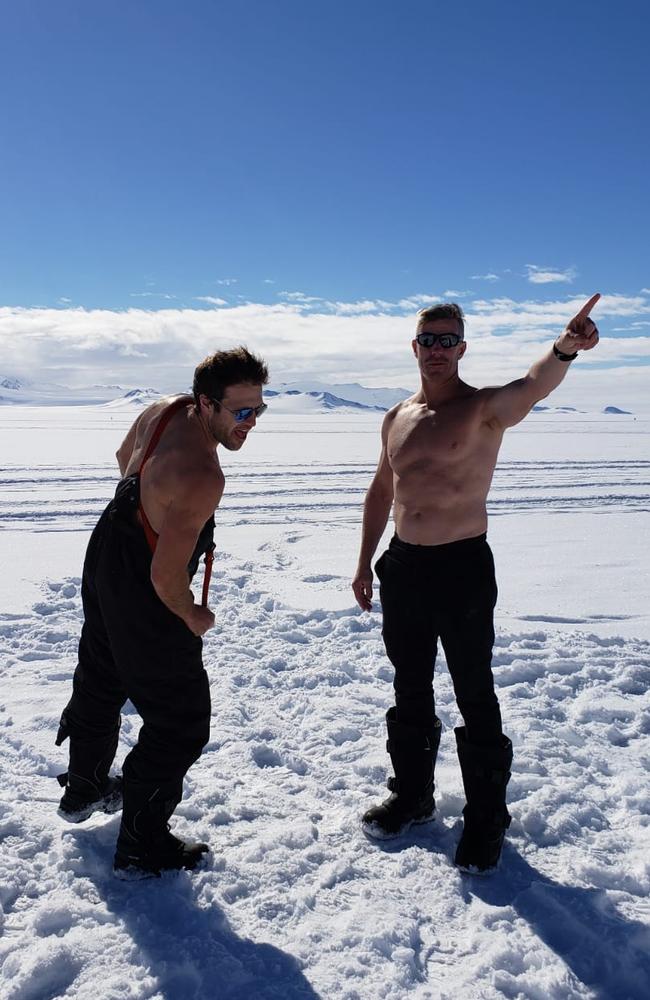
Monday, 17 December 2018
Everyone arrives at the mess tent looking for information about our departure. There are rumours flying around and all sorts of ill-informed guesses. I made a few of my own.
We are told to pack up and that the Ilyushin was hoping to leave Puntas at 5.30pm. If it does, we can get out just before midnight.
Everyone is nervous, but we pack up and wait until 5pm for the announcement. There was a massive roar when, at about 5.20pm, we are told that the Ilyushin managed to take off and that our chances of leaving looked good — although still not certain.
Eventually the Ilyushin landed — with everyone cheering on the plane — and we could make our escape.
It was a once in a lifetime experience. The race was one thing — but spending eight days on the ice not knowing when we might leave without having any connection back to home was probably the real experience. One I’ll never forget.



